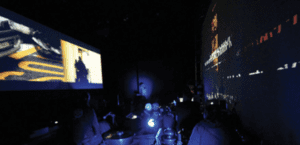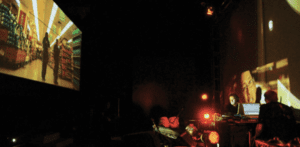Read the chapters on Live Cinema by Gabriel Menotti and Live Audiovisual Performance by Ana Carvalho from The Audiovisual Breakthrough (Fluctuating Images, 2015). Armed with the knowledge you gained last week by reading the chapter on VJ-ing and by watching the documentary Video Out (Finkelstein & Vlachos, 2005), write a two paragraph reflection on the difference between VJ-ing, Live Cinema, and Live Audiovisual Performance. Reference one contemporary artist / group / collective from each category as an example to indicate the differences in context, methodology, and technology (if any!).
When considering the differences between VJ-ing, Live Cinema and Live Audiovisual Performance, it is important to recognize the subtle details that separate the different mediums. Live Audiovisual Performance is like the umbrella that encompasses a variety of audiovisual performances, while VJ-ing and Live Cinema are subsets of the larger category. The art forms themselves, and other like it, all fall under a certain type of Live Audiovisual Performance, but all posses unique features which distinguish themselves from their contemporaries.
In my personal opinion, VJ-ing is a much more improvisational and “live” form of the artistic medium. It requires VJ artists, much like DJ’s, to mix different forms of media and visuals with the music that is being played. Additionally, VJ-ing sometimes is overshadowed by their musical counterpart, as VJ artists in certain settings, are only in control of visuals, and may sometimes be unfairly categorized as an addition to the music, rather than an equal. On the other hand, Live Cinema is much more of a pre-planned, and meticulous process, intended to be consumed much like in a traditional cinema. This is not to discredit VJ-ing, as practice is still an important component of the process, however, Live Cinema contains a much more concrete progression, and is entirely in control by the artist(s).
Live Audiovisual Performance: Ryoji Ikeda
Ryoji Ikeda is known for his elaborate and large audiovisual installations. Although he is unable to attend and perform for every single exhibition, he has on multiple occasions, has performed live using the audiovisual medium.
Live Cinema Example: Granular Synthesis- Modell 5
Granular Synthesis’ Modell 5 is an example of live cinema. Similar to traditional forms of cinema, viewers take the backseat not as participants in any interaction, but merely as spectators watching the artistic expression of the artist(s).
VJ-ing Example:
For my VJ-ing example, I chose the class example of Gridspace’s live performance at the Mutek Festival. This is a clear example of the VJ-ing art form, with the live automation of both visuals and music taking center stage.

